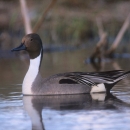Featured Species
The refuge was created to protect migratory birds and their habitats, as well as to conserve endangered and threatened species. The refuge and its surrounding waters support many species of resident and migratory fish and wildlife. The fish and wildlife populations are influenced by a number of factors: the refuge’s location along the Atlantic Flyway for waterfowl, shorebirds, wading birds, and neotropical migratory songbirds; the brackish water surrounding the refuge; and the nature of the habitat on the refuge. The refuge is home to concentrations of snow and Canada geese, ducks, warblers, shovelers, osprey and other raptors, wading birds, and shorebirds. An active wood duck breeding population is present, along with a variety of reptiles, amphibians and mammals.
Of the species on the refuge, 187 species are birds; 118 are fish; 78 are reptiles and amphibians; and 23 are mammals. Conservation agencies and organizations have listed many bird species as high priority or rare and of special concern. These include the prairie warbler, hooded warbler, black-throated green warbler, yellow-throated warbler, prothonotary warbler, northern parula, sharp-tailed sparrow, northern bobwhite, king rail, black rail, solitary sandpiper, semipalmated sandpiper, black tern, American black duck, American woodcock, short-eared owl, and American kestrel. Wintering and migrating waterfowl make extensive use of the refuge's wetlands. Principal species include the snow goose, tundra swan, mallard, wood duck, American black duck, American wigeon, green-winged teal, gadwall, and northern pintail.
The marshes surrounding Currituck Sound, Back Bay, and Knotts Island Bay provide habitat for a substantial portion of the most commonly harvested duck species in North Carolina. Wooded wetlands are very important to wintering waterfowl as prime sources of cover and food, providing supplemental dietary needs prior to spring migration, mating, and nesting. Migratory mallards, American black ducks, and some wood ducks utilize coastal fringe evergreen forests primarily in the fall and winter months. They often feed on the vegetable matter found in shallow water, and for migration and pre-breeding activities they supplement this with the high protein foods found in the wooded wetlands, including acorns; beechnuts; the seeds of buttonbush; bald cypress and tupelo gums; insects; and the abundant floodplain aquatic invertebrates such as snails, crustaceans, and insects.

